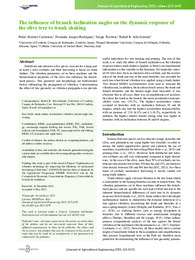Por favor, use este identificador para citar o enlazar este ítem:
https://hdl.handle.net/11000/37198Registro completo de metadatos
| Campo DC | Valor | Lengua/Idioma |
|---|---|---|
| dc.contributor.author | Sánchez Cachinero, Pedro | - |
| dc.contributor.author | Aragón Rodríguez, Fernando | - |
| dc.contributor.author | Tombosi, Sergio | - |
| dc.contributor.author | Sola Guirado, Rafael Ruben | - |
| dc.contributor.other | Departamentos de la UMH::Ingeniería | es_ES |
| dc.date.accessioned | 2025-09-03T10:10:51Z | - |
| dc.date.available | 2025-09-03T10:10:51Z | - |
| dc.date.created | 2025-06 | - |
| dc.identifier.citation | Journal of Agricultural Engineering (JAE) Vol. 56 No. 3 (2025) | es_ES |
| dc.identifier.issn | 2239-6268 | - |
| dc.identifier.issn | 1974-7071 | - |
| dc.identifier.uri | https://hdl.handle.net/11000/37198 | - |
| dc.description.abstract | Traditional and intensive olive groves account for a large part of today’s olive orchards and their harvesting is based on trunk shakers. The vibration parameters set in these machines and the biomechanical properties of the olive tree influence the detachment process. Tree geometry and morphology are fundamental factors influencing the propagation of vibration. Understanding the effect of tree geometry on vibration propagation can provide useful indications for tree training and pruning. The aim of this work is to study the effect of branch inclination on the vibration response when a trunk shaker is applied, as there is no experimental information on this variable in the literature. We randomly selected 80 olive trees from an intensive olive orchard, and the acceleration of the trunk and one of the main branches was recorded for each tree when forced vibration was applied using a trunk shaker. Two triaxial MEMS accelerometers were used to measure the vibration and, in addition, the location of each sensor, the trunk and branch diameters and the branch angle were measured. It was observed that in all cases there was an amplification of acceleration from the trunk to the branch: the mean acceleration transmissibility value was 139.5%. The highest acceleration values occurred in branches with an inclination between 30 and 60 degrees, which also had the highest acceleration transmissibility, with an increase of 13.8-16.8% and 6.3-10.5%, respectively. In addition, the highest relative kinetic energy ratio was higher in branches with an inclination between 30 and 60 degrees. | es_ES |
| dc.format | application/pdf | es_ES |
| dc.format.extent | 9 | es_ES |
| dc.language.iso | eng | es_ES |
| dc.publisher | PAGEpress | es_ES |
| dc.rights | info:eu-repo/semantics/openAccess | es_ES |
| dc.rights.uri | http://creativecommons.org/licenses/by-nc-nd/4.0/ | * |
| dc.subject | trunk shaker | es_ES |
| dc.subject | acceleration | es_ES |
| dc.subject | vibration | es_ES |
| dc.subject | branch angle | es_ES |
| dc.subject | harvesting | es_ES |
| dc.title | The influence of branch inclination angles on the dynamic response of the olive tree to trunk shaking | es_ES |
| dc.type | info:eu-repo/semantics/article | es_ES |
| dc.relation.publisherversion | https://doi.org/10.4081/jae.2025.1670 | es_ES |

Ver/Abrir:
jae-56-3-1670.pdf
484 kB
Adobe PDF
Compartir:
 La licencia se describe como: Atribución-NonComercial-NoDerivada 4.0 Internacional.
La licencia se describe como: Atribución-NonComercial-NoDerivada 4.0 Internacional.
.png)